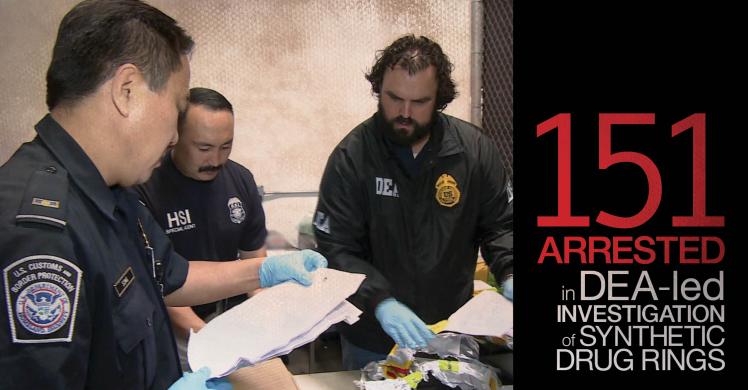Contact: DEA Public Affairs
(202) 307-7977

151 Arrested in DEA-Led Investigation of Synthetic Drug Rings
Rogue Chinese labs producing for U.S. and global consumption; proceeds flow to Middle East countries
OCT 15 (WASHINGTON) - The Drug Enforcement Administration (DEA), Immigration and Customs Enforcement (ICE) Homeland Security Investigations (HSI), Customs and Border Protection (CBP), along with other federal, state, and local law enforcement today concluded a 15-month, nationwide drug interdiction effort that resulted in 151 arrests in 16 states. The enforcement action, known as Project Synergy III, targeted the synthetic designer drug industry, including wholesalers, money launderers and other criminal facilitators. In addition to curbing the flow of synthetic drugs into the country, Project Synergy III continues to reveal the flow of millions of dollars in U.S. synthetic drug proceeds to countries of concern in the Middle East.
 |  |
| Guns, money and synthetic drugs seized as part of Project Synergy III | Seized drugs as part of Project Synergy III |
Total cash and assets seized (approximately): $15,013,522.25
Synthetic Cathinones seized: 316 kilograms
Synthetic Cannabinoids: 3,058 kilograms
Treated plant material: 98 kilograms
Synthetic Cannabinoid Packs (filled): 7,314 kilograms
Weapons: 39
Arrests: 151
Search Warrants: 69
“This poison ruins and takes too many lives; this is incredibly dangerous stuff,” said DEA Acting Administrator Chuck Rosenberg. “Project Synergy III demonstrates our collective commitment to pursue those who produce and distribute this garbage to our children and I am grateful for the partnership of HSI and CBP on this operation.”
"The availability and illicit marketing of synthetic drugs creates the impression that they are safe and legal, when in fact they are neither," said ICE Director Sarah R. Saldaña. "ICE is committed to working with our law enforcement partners to stop the flow of these highly dangerous drugs into our country. At the same time, we are equally concerned about getting the word out - especially to young people -- about the dangers, and potentially deadly consequences, of using these substances."
“With the alarming growth of these synthetic drugs, CBP’s National Targeting Center, Laboratory and Scientific Services and Office of Field Operations bring expertise and innovative contributions to the U.S. government’s effort to keep these dangerous narcotics off the streets,” said CBP Commissioner R. Gil Kerlikowske. “CBP personnel continue to serve on the frontline, protecting the American public from designer drugs, a highly dangerous and deceptive group of psychoactive substances, specifically designed to skirt around existing drug laws.”
As in previous phases of Project Synergy, CBP’s National Targeting Center played a significant role in the success of this operation. CBP was responsible for identifying and targeting high-risk express consignment shipments coming into the United States and suspected of containing synthetic drugs.
For the past several years, DEA has identified over 400 new designer drugs in the United States – the vast majority of which are manufactured in rogue labs in China and sold on the Internet and in retail outlets such as smoke shops, gas station convenience stores, and bodegas. Abuse of these psychoactive substances has resulted in ever-increasing numbers of overdose incidents and deaths.
Other related interdiction operations preceded this operation. Most recently in September, federal law enforcement teamed up with HSI, the New York City Police Department, and other law enforcement agencies to target nearly 90 bodegas in New York City who were selling designer synthetic drugs.
Communities, families, and individuals, across the country have experienced the scourge of designer synthetic drugs, which are often marketed as herbal incense, potpourri, bath salts, jewelry cleaner, or plant food. Synthetic cannabinoids represent the most significant class of designer synthetic drugs. According to the National Forensic Laboratory Information System (NFLIS), substances identified as synthetic cannabinoids by federal, state, and local forensic laboratories increased from 23 reports in 2009 to 32,784 reports in 2013; to 37,500 reports in 2014.
These dangerous drugs have caused significant abuse, addiction, overdoses, and emergency room visits. Those who have abused synthetic drugs have suffered vomiting, anxiety, agitation, irritability, seizures, hallucinations, tachycardia, elevated blood pressure, and loss of consciousness. They have caused significant organ damage as well as overdose deaths.
The contents and effects of synthetic drugs are unpredictable due to a constantly changing variety of chemicals used in manufacturing processes devoid of quality controls and government regulatory oversight.
Enforcement B-Roll can be found here:
http://dvidshub.net/r/8cchtx
https://www.dvidshub.net/search?q=synergy+lll
More information about synthetic designer drugs can be found on the Drug Fact Sheets
Read more about the previous phases of Project Synergy with photos and B-roll:http://www.dea.gov/divisions/hq/2014/hq050714.shtml
http://www.dea.gov/divisions/hq/2013/hq062613.shtml
B-roll from Project Synergy II (May 2014) is available at: http://dvidshub.net/r/ff5tjb
Previous B-roll from Project Synergy I (June 2013) is available at:http://www.dvidshub.net/video/294719/cbp-dea-project-synergy-b-roll#.U2pFq3b6-So
Parents and children are encouraged to educate themselves about the dangers of drugs by visiting DEA’s interactive websites at www.JustThinkTwice.com,www.GetSmartAboutDrugs.com and www.dea.gov
No comments:
Post a Comment
Comments always welcome!